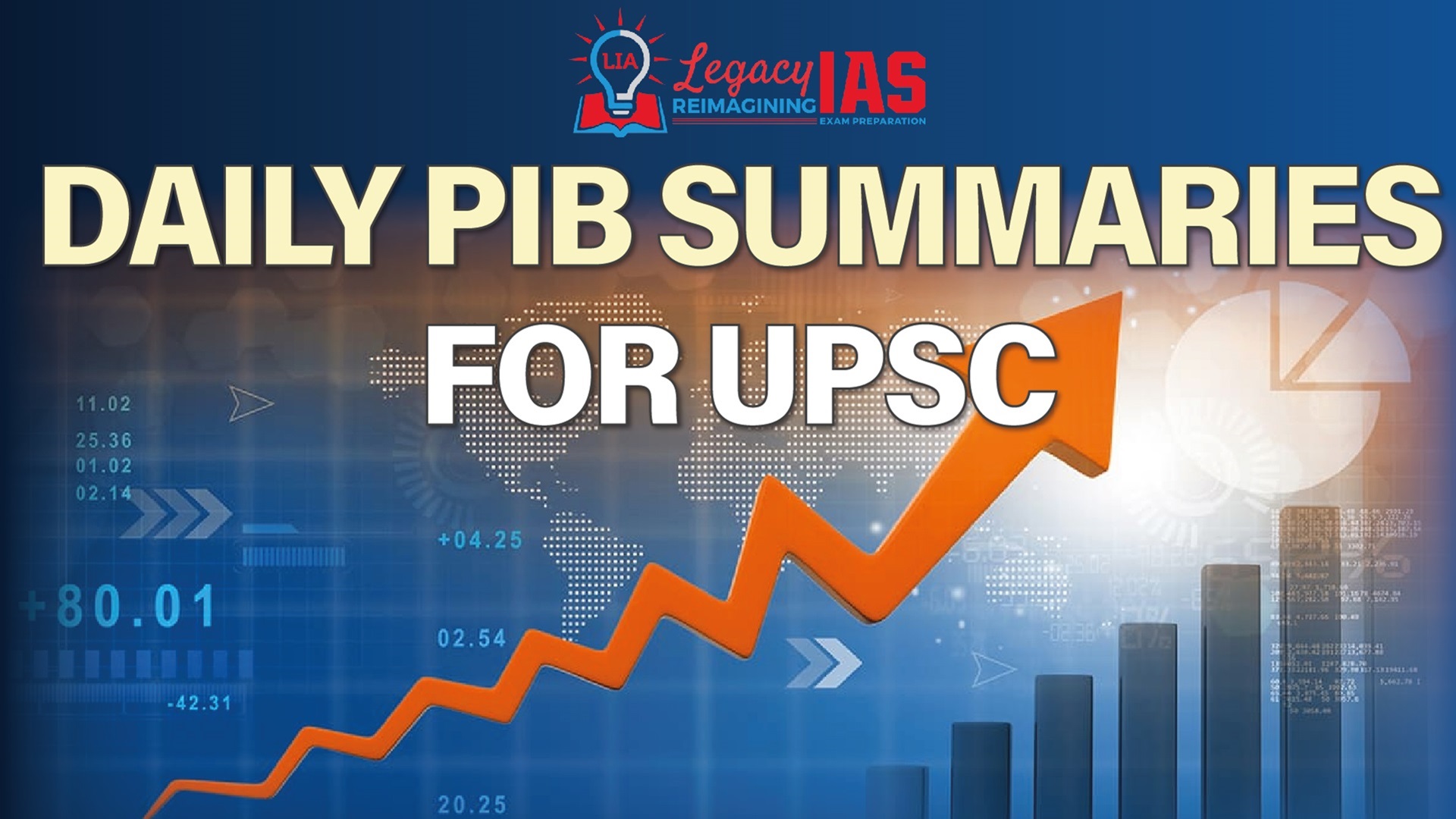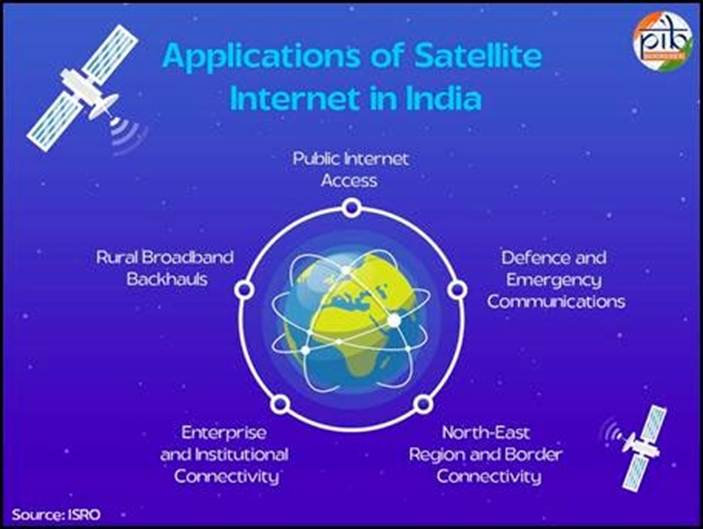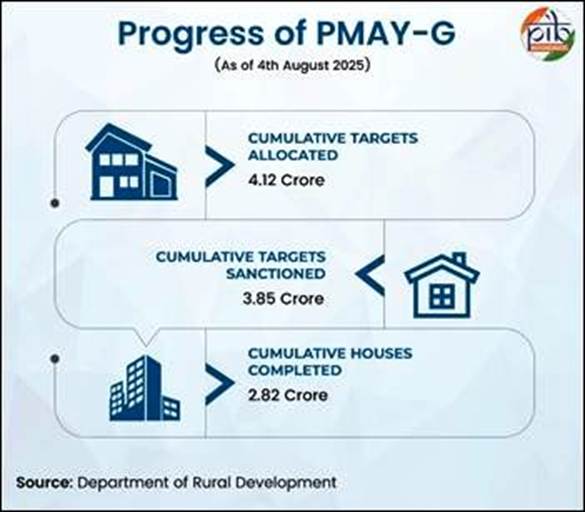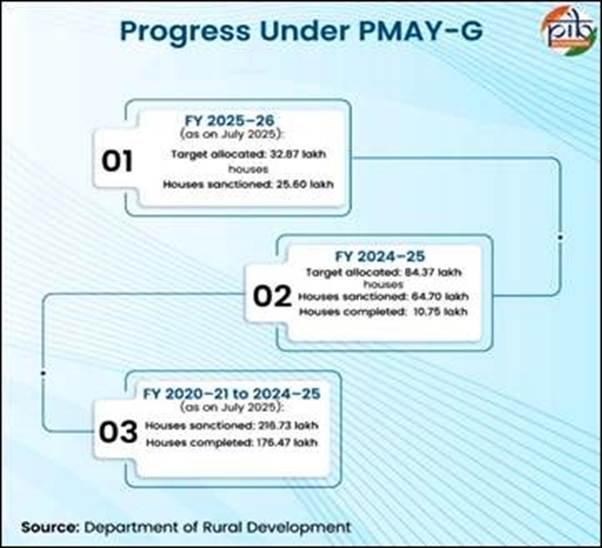Published on Sep 24, 2025
Daily PIB Summaries
PIB Summaries 24 September 2025

Content
- Satellite Internet in India
- PMAY-G: Empowering Rural India through Housing for All
Satellite Internet in India
What is Satellite Internet?
- Definition: Internet connectivity delivered through satellites in orbit (Geostationary, Medium Earth, Low Earth).
- Why needed in India?
- Over 1 billion internet users, but rural penetration only ~46/100 people.
- Remote, hilly, border, and island regions remain underserved.
- Terrestrial solutions (fiber, towers) are costly/unviable in such areas.
Relevance :
- GS 2 (Governance): Digital inclusion, service delivery in remote regions, role of DoT, TRAI, IN-SPACe, and Telecom Act 2023.
- GS 3 (Science & Technology): Satellite communication technology, LEO/MEO transition, orbital debris, cybersecurity.
- GS 3 (Economy): Broadband penetration, MSMEs, startups, e-commerce, rural economy growth.

Institutional & Policy Ecosystem
- Space Sector Reforms (2020): Opened private participation.
- Indian Space Policy 2023: Enabled NGEs to participate across the space value chain.
- DoT: Grants Unified Licence authorisations; empowered by Telecom Act 2023 for spectrum/security.
- TRAI (2025 recommendations): Satellite spectrum allocation for 5 years (extendable by 2 years).
- IN-SPACe: Promotes, authorises, supervises private satellite internet activities; bridge between ISRO & private sector.
- NSIL: ISRO’s commercial arm, operating 15 communication satellites, demand-driven missions (GSAT-24, GSAT-20, GSAT-N3 upcoming).
Technological Transition
- Traditional: Dependence on ISRO’s GSAT (GEO-based).
- Shift: LEO (400–2000 km) → low latency, high bandwidth; MEO (8,000–20,000 km) → wider coverage, moderate latency.
- Spectrum Bands: S, C, Extended C, Ku, Ka.
- High-Throughput Satellites (HTS): GSAT-19, GSAT-29, GSAT-11, GSAT-N2 → use spot-beam tech for faster speeds and high capacity.
Industry Developments
- Private Entry:
- Starlink licensed in June 2025.
- Jio Satellite & OneWeb licensed earlier.
- 10 satellite operators applied for authorisation.
- FDI Liberalisation: Up to 100% FDI permitted, automatic/government routes.
- Market Potential: Rising demand for affordable broadband in rural/remote India + enterprise solutions (aviation, shipping, defence).
Government Initiatives to Expand Connectivity
- Digital Bharat Nidhi (ex-USOF): Funds rural connectivity projects (4G saturation).
- Comprehensive Telecom Development Plan (CTDP):
- Islands: BSNL satellite augmentation (Andaman: 2 → 4 Gbps; Lakshadweep: 318 Mbps → 1.71 Gbps).
- North-East: 2,485 towers, 3,389 villages covered (till June 2025).
- National Broadband Mission (NBM 2.0): Extend broadband to 1.7 lakh villages.
- BharatNet: 2.14 lakh Gram Panchayats connected (Phase II includes satellite component via BBNL & BSNL).
- PM-WANI: 3.73 lakh public Wi-Fi hotspots installed (as of Sept 2025).
- MoES GIS-DSS: Uses internet for impact-based weather warnings and disaster risk mitigation.
Applications of Satellite Internet
- Social: Rural education, telemedicine, digital payments, online governance.
- Economic: MSMEs, startups, e-commerce penetration in rural India.
- Strategic: Defence networks, secure communications in border regions, disaster recovery.
- Technological: Aviation, shipping, autonomous vehicles, IoT, remote sensing synergy.
Challenges & Concerns
- Regulatory: Spectrum pricing, licensing clarity, security risks.
- Cost: User affordability vs. high equipment cost (antennas, receivers).
- Competition: Balancing private foreign operators (Starlink) with indigenous capacity.
- Cybersecurity: Data interception risks in satellite links.
- Space Traffic Management: Rising LEO constellations → orbital debris, collision risk.
Strategic & Geoeconomic Significance
- Digital Inclusion: Bridges rural-urban digital divide.
- Viksit Bharat 2047 Vision: Equitable access to high-speed internet as a driver of development.
- Global Positioning: India emerges as both a market hub and technology provider.
- Self-reliance: ISRO-NSIL + private sector synergy reduces dependence on foreign constellations.
- Strategic Autonomy: Secure satcom strengthens defence and disaster preparedness.
Way Forward
- Short-term (till 2030):
- Expand LEO/MEO networks in partnership with private players.
- Integrate satellite internet into BharatNet/PM-WANI.
- Medium-term (2030–2040):
- Build indigenous LEO constellations (to compete with Starlink/OneWeb).
- Enhance cybersecurity & orbital debris management protocols.
- Long-term (towards 2047):
- Global leadership in affordable satellite broadband.
- Export capacity to Global South (Africa, ASEAN).
- Position India as a digital infrastructure power complementing its space leadership.
PMAY-G: Empowering Rural India through Housing for All
Background
- Launch: 1st April 2016, successor to Indira Awaas Yojana.
- Objective: “Housing for All” in rural areas by providing pucca houses with basic facilities.
- Minimum unit size: 25 sq. m including hygienic cooking space.
- Assistance amount: ₹1.20 lakh (plains) and ₹1.30 lakh (hilly/NE/Himalayan states).
- Funding pattern:
- 60:40 (Centre: State) in plains.
- 90:10 in NE & Himalayan states.
- 100% central funding in UTs without legislature.
Relevance :
- GS 2 (Governance): Welfare delivery, DBT, Aadhaar integration, transparency (AwaasSoft, geo-tagging, social audits).
- GS 3 (Economy): Employment generation, rural construction sector multiplier, skill development (rural masons).
- GS 1 (Society): Social empowerment, dignity, women ownership, equity for SC/ST and PwD.
- GS 2 (Social Justice): Inclusive development, convergence with SBM, MGNREGS, LPG, electricity.

Scale and Progress
- Cumulative target: 4.95 crore houses (2016–29).
- Allocation (till Aug 2025): 4.12 crore houses.
- Sanctioned: 3.85 crore houses.
- Completed: 2.82 crore houses (68% completion rate).
- FY 2024–25 performance: 84.37 lakh target → 64.7 lakh sanctioned.
- Employment impact: 568 crore person-days generated (2016–25).
Beneficiary Identification & Inclusion
- Primary data base: SECC 2011 housing deprivation indicators.
- Verification: Gram Sabha scrutiny + appellate mechanism.
- Inclusion of left-out households: Awaas+ survey (2018–19) and Awaas+ 2024 app-based survey.
- Equity norms:
- 60% SC/ST households.
- Priority for landless.
- 5% for Persons with Disabilities (as per RPwD Act 2016).

Beyond Housing – Convergence & Socio-economic Linkages
- Livelihoods: 90–95 person-days of MGNREGS work per house (≈₹27,000).
- Skill development: 2.97 lakh trained rural masons (some employed abroad).
- Sanitation: Toilet construction (₹12,000 under SBM-G).
- Amenities: Access to piped drinking water, LPG, electricity via convergence.
- Local economy multiplier: Boost to construction material supply chains and transport.
Technology-Driven Implementation
- Digital backbone: AwaasSoft MIS + AwaasApp for monitoring progress.
- Transparency tools:
- Geo-tagged & time-stamped photographs of construction stages.
- Aadhaar-based DBT via PFMS (100% ABPS compliance).
- AI/ML fraud detection, e-KYC, face authentication, liveness detection.
- Accountability:
- Social audit in every Gram Panchayat (annual).
- Multi-level grievance redressal (CPGRAMS, e-ticketing, district appellate).
Innovations for Inclusivity & Quality
- House design typologies: Region-specific, disaster-resilient, culturally appropriate, available in 3D via app.
- Landless module: Tracking land allotment for beneficiaries.
- Employment multiplier: ~201 person-days (skilled, semi-skilled, unskilled) generated per house.
Institutional & Administrative Mechanisms
- Ministry of Rural Development: Nodal body for PMAY-G.
- State governments & Gram Sabhas: Execution and beneficiary verification.
- Monitoring: Central dashboards, micro-level reviews, real-time analytic dashboards.
- Acceleration strategies: Priority to incomplete houses, fund release linked to progress, regular reviews at ministerial level.
Broader Impacts
- Social: Provides dignity, security, and women empowerment (houses often in women’s names).
- Economic: Stimulates rural economy, employment, skilling.
- Health: Safe housing reduces vulnerability to diseases, natural disasters.
- Environment: Push towards disaster-resilient designs, convergence with clean energy.
- Governance: Transparent, tech-enabled model as a benchmark for other welfare schemes.
Challenges Ahead
- Land availability for landless beneficiaries.
- Ensuring timely fund release & construction completion.
- Maintaining quality across states with diverse geo-climatic conditions.
- Continuous updating of beneficiary lists beyond SECC 2011.
- Digital literacy & accessibility for beneficiaries in remote areas.
Comprehensive Significance
- Poverty Alleviation: Moves households from kutcha to pucca housing, breaking poverty cycles.
- Rural Prosperity Catalyst: Housing → dignity → sanitation → jobs → social inclusion.
- Model for Welfare Delivery: Combines DBT, convergence, technology, and accountability.
- Viksit Bharat 2047 Vision: Strengthening rural foundations by ensuring every household has secure housing by 2029.
